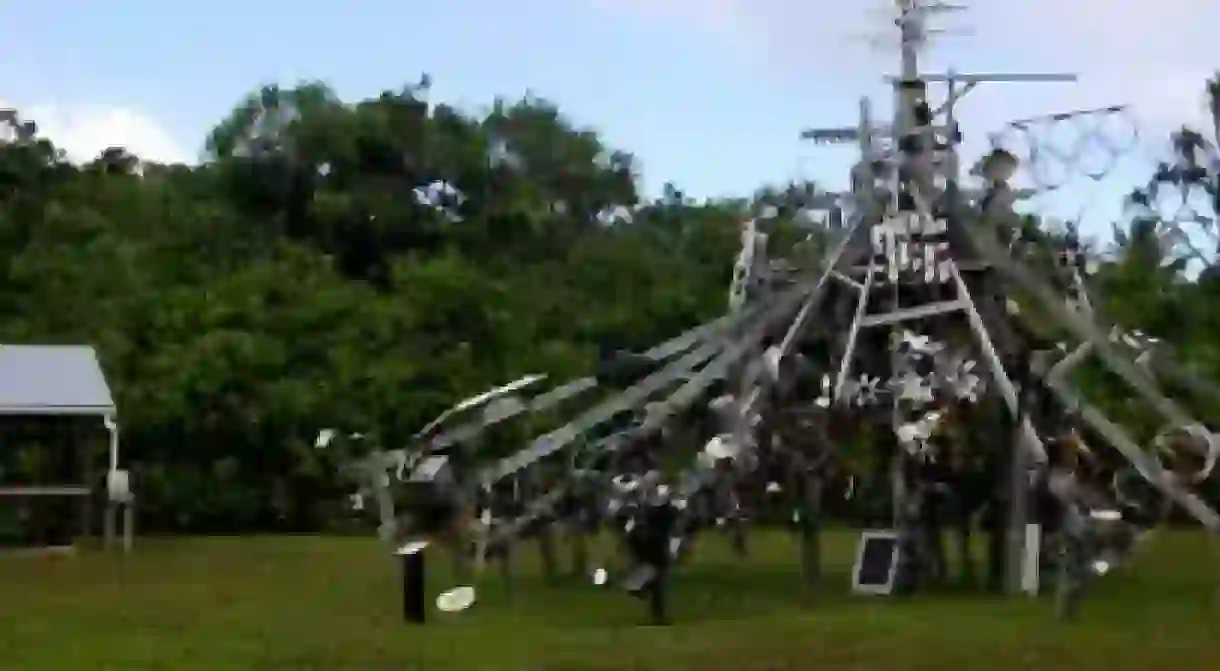Niue's Hikulagi Sculpture Park: A Global Microcosm

Sitting incongruously in the middle of the natural rainforest of the Pacific Island of Niue is a physically small but conceptually monumental treatise on global environment concerns, the Hikulagi Sculpture Park. Artist Mark Cross explains why this remote island sculpture park is of international relevance.

The Hikulagi Park was established in 1996 by members of the then Tahiono Arts Collective, a small group of artists and art enthusiasts who had returned to their Pacific home, countering the trend of urban drift that has devastated many rural and island populations in the Pacific. In the case of Niue, much of the land was abandoned after having been rendered largely infertile by naive colonial horticultural methods. The artists saw this land as a tabular rasa, a blank canvas where they could produce works of art that not only enhanced the land but also spoke of the very cause of its infertility. Several acres of such land south of the eastern village of Liku were at the artists’ disposal and, while being ideal for the purpose of the artists’ environmental concerns, it was also ironically surrounded by the pristine rainforest which once covered the now degraded land.

The park’s concept embraces the sentiment that an island is analogous to Planet Earth in microcosm, and so is intended to foment discussion on issues such as, pollution, climate change and human co-existence.It is a place where the intrinsic and unique qualities of Niuean Culture and environment can be shared with the world while attracting attention to Niue through the medium of contemporary sculpture, a medium seen nowhere else in the Pacific Islands.
Its intention is to do this through audience participation and the predominant utilisation of the found object; that is to say, the artists and community make sculpture from the inorganic waste created by contemporary consumer society.
With this in mind, the centrepiece of the park is the monumental sculpture called ‘Protean Habitat’ which epitomises the ideals behind the Hikulagi Sculpture Space. On-going and interactive, it is an art project that does not have any perception of a finite conclusion. Based on a wooden substructure, it is an assemblage sculpture fundamentally constructivist in its utilisation of the found object that can easily be attached with the most basic of tools, enabling passers-by to add their own input.

Personally, as an artist with over 30 years of association with the island of Niue, I have been alert to the layers upon layers of humanity that has come and gone here, leaving small elements of their lives making a small community into a living organic organism. In such an isolated community this awareness becomes more acute, and you realise what you are experiencing is a microcosm of the whole world.
In its state of ever-changing growth the sculpture reflects the state of the world and the refuse that humanity is accumulating in its juggernaut consumerist path to who-knows-where. This vagueness of direction and final outcome of humanity are then reflected in the unexpected directions the sculpture will take during its growth and the fact that it will grow ad infinitum.

The first sculpture to be established at the park was by Niuean returnee Mikoyan Vekula, who grew up in Wellington, New Zealand. ‘Odesyk’ is a six metre semicircle of six totem poles of native Kafika hardwood decorated intricately with cut and inverted beer cans. The circle is completed by limestone rocks known as Makatea throughout Polynesia. Resisting the Polynesian artist trend of introspection in his imagery, Vekula draws from a number of indigenous cultures including Australian, American and Celtic .The totems in this esoterically titled sculpture depict a family, with the guardians on each end of the semicircle and the four children in the middle. At the centre of the circle is a bench intended for the viewer’s contemplation and meditation.
Several more ephemeral artworks have been created by artists who just happen to be passing through Niue. A good example is ‘Web’, a sculpture created by environmental artist Meri Heitala from Helsinki which has been made by stringing telephone wire, spider-web-like, between two coconut trees while attaching drink can tear tabs, which suggests captured insects. In this way, such ephemeral sculptures are encouraged to enlist the input from visiting artists who may not have the time to create something more permanent.

A recent project that is more of an enclosure than a sculpture is ‘Sale’s Fale’ (pronounced Sarley’s Farley), fale being the generic word for house or building in Polynesia. Like ‘Protean Habitat’, this sculpture is an ongoing project but in memory of the Niue High School art teacher and sculpture park co-founder Charles Jessop who passed away in 2012. New Zealand-born, Charles was representative of the heroic return of the Niue Diaspora against all the odds. He is remembered by his many students, the Niue art Community and the Niue public in general, as a humble and diligent contributor to the country. With this in mind, the sculpture is in the form of a monumental montage constructed by the Niue community through the biennial competition ‘The Charles Jessop Memorial Sculpture Prize’
Beyond this local as well as transient participation in the project, the sculpture park organisers hope to expand the already cleared land area in future so that established artists from around the world can contribute to its on-going evolution.
The Hikulagi Sculpture space to date is being created through the voluntary labour of various individuals and businesses on Niue. Initial funding at its inception was provided by the Pacific Development and Conservation Trust as well as the then Aus-Aid Cultural Fund. The space has been supported by Reef Shipping and Niue Tourism has helped with some construction and on-going maintenance.

By Mark Cross













